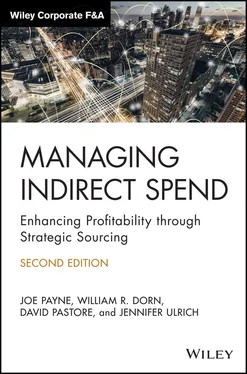The baseline report should also summarize any contractual considerations related to the spend category. This section should detail existing obligations, provide insight into the current agreement termination date, and identify clauses dealing with termination before that date. It should also provide an assessment of specific requirements regarding the scope of work, insurance, liability, and other important contract clauses. Finally, this section of the report should provide some context for how these obligations will be addressed during the sourcing process.
By now, you have developed a full analysis of your current supplier's cost structure, service levels, and contractual requirements. This has helped you turn data into useful information that you can now use to develop a preliminary sourcing strategy.
A preliminary sourcing strategy describes the course of action to take after completing the Data Collection phase. It defines the type of research to perform, the types of suppliers to contact, and the rationale for these decisions. Some factors to consider include the following:
How many suppliers do we currently utilize?
Are there other suppliers in the marketplace that provide this product or service?
Do we have a contractual obligation with our current supplier? What happens if that obligation is not fulfilled?
When was the last time we negotiated this contract?
How integrated are we with the current supplier(s)? Will there be a high cost of change?
Does it make sense to aggregate all the spend in this category together or to look at components of it separately?
At this point in the process, you have probably developed a basic understanding of the marketplace, but you are by no means an expert. As you move into the research phase, you might find that your preliminary sourcing strategy was missing steps, or you might find that a different approach altogether is more appropriate. This is okay—the preliminary strategy is essentially a draft concept. The research process helps further refine and develop the strategy.
Now that you have created the baseline report, it is time to present this information to your team. As we discussed earlier in the chapter, your team includes both stakeholders (those with direct involvement in managing the spend or working with the suppliers) and the executive(s) sponsoring the project. Oftentimes, supplier relationships are subjective, especially to those who work closest with the suppliers. Providing an objective assessment of the current supply situation (and having stakeholders agree with it) is the first step in the consensus‐building process, critical to future assessments. If the stakeholders do not agree on your starting point, it will be more difficult for them to accept change later on.
Executives also need to be briefed on your baseline, but for a different reason. For the executive team and other sponsors, understanding the process undertaken to collect data and build the initial baseline assessment provides context for the project scope and a basic knowledge of your starting point. This makes bringing them up to speed much easier if their assistance is needed later on in the process. It also demonstrates credibility, in that you started the project in an objective way that they could agree with.
Remember, at this stage in the process it is not clear if changing suppliers or altering processes will be necessary, but in a Strategic Sourcing initiative, those events should always be considered as possibilities. Change management is not always easy, but a project that is done inside a bubble with no involvement from others will typically fail if change becomes necessary. Reviewing and agreeing to a baseline with those involved often seems like an unnecessary step. After all, why would you present to them what they already know? But this initial step creates an easy win by demonstrating that you understand the category and that the process you are about to undertake will be an objective one.
Once you have obtained team agreement on a starting point, the Research phase of the project can begin.
CHAPTER 3 Conducting Research
MANY PROFESSIONALS THINK the biggest challenge of the Research phase is knowing what to look for, but it is often equally challenging and important that you know where to look. This phase of a Strategic Sourcing initiative requires both creative, out‐of‐the‐box thinking and business acumen. Its purpose is to use the information that you analyzed during the Data Collection phase to develop market intelligence and begin identifying potential opportunities for cost reduction.
TYPES OF COST‐SAVINGS OPPORTUNITIES
Organizations typically realize cost savings through three primary methods: leveraging data intelligence, making process improvements, and choosing new products or services.
Organizations most often act on cost‐savings opportunities by using the information from the Data Collection and Spend Analysis phase to achieve a lower net price for a specific product or service. The goal is to gain advantages that less‐informed customers might miss out on. You can secure these lower prices through negotiations or a transition to a new supplier. To identify these opportunities, you'll want to gather intelligence related to potential alternate suppliers, including soliciting pricing proposals.
Remember that the Strategic Sourcing can do more than lower unit hard costs. It also involves investigating and implementing efficiencies that can result in decreased processing time, lower transaction costs, and enhanced support for the procurement and supply chain management units within your organization. Process improvements and product or service changes are often overlooked during Strategic Sourcing initiatives; however, these factors have the potential to reduce overall spend much more than unit cost negotiations. Just because you currently process orders a certain way or use one type of technology to support a requirement does not necessarily mean that those are the best or most efficient methods. During the Research phase, you'll begin to explore the alternatives as they relate to technology, processes, products, and services.
In this chapter, we review the components of the Research phase of a sourcing initiative. More importantly, we identify what to look for in your research. We also discuss the predominant method for collecting this information—the request for information, or RFI.
UNDERSTANDING THE CATEGORY
During the Research phase of your initiative, you are taking your preliminary ideas, adding context to them (gained through Data Collection and Spend Analysis), and converting them into a final sourcing strategy. To accomplish this, you need to gain a broad understanding of the category you're sourcing. This sounds like a simple concept, but many professionals don't take time to understand the nuances of the categories they're sourcing. Many rely instead on documentation provided by their predecessors, “legacy processes.”
Relying on previous work alone is potentially dangerous for several reasons. First, suppliers can easily pick up on your lack of understanding and insight into the spend category. If they know you're not familiar with the market, they may offer higher‐than‐average prices—and they'll probably get away with it.
Second, without some market you may not be able to successfully identify all the suppliers in the marketplace, or you may overlook the right types of suppliers. We review types of suppliers in greater detail later in the chapter, but for now, a simple example would be a manufacturer versus a distributor. Currently, you may buy all your copy paper through a distributor, such as Staples. However, if the volume of paper you consume is great enough and your organization has the inventorying capabilities, it may make more sense to contract directly with a paper manufacturer and purchase paper by the truckload. Without a firm understanding of the market, you may overlook this type of opportunity.
Читать дальше












